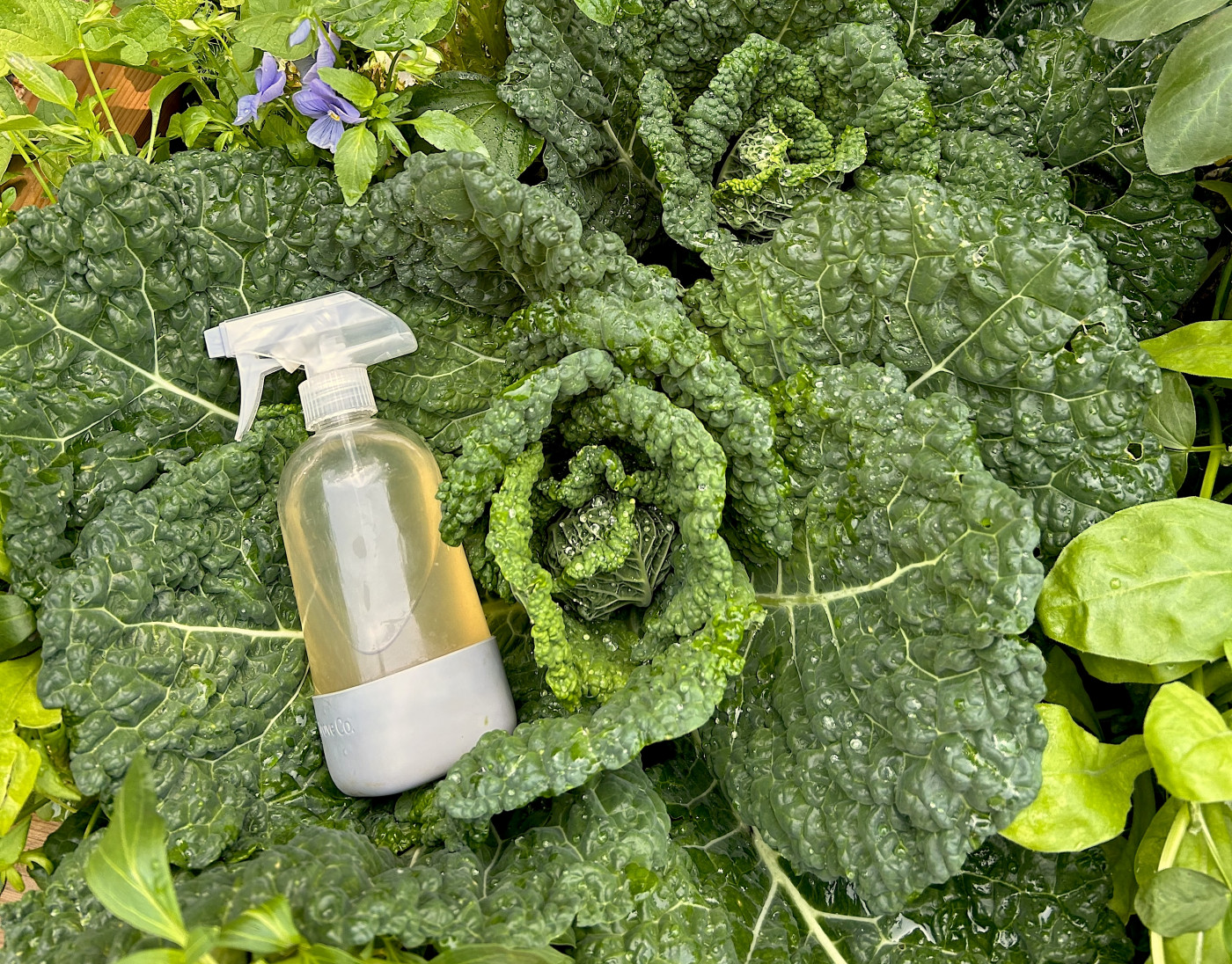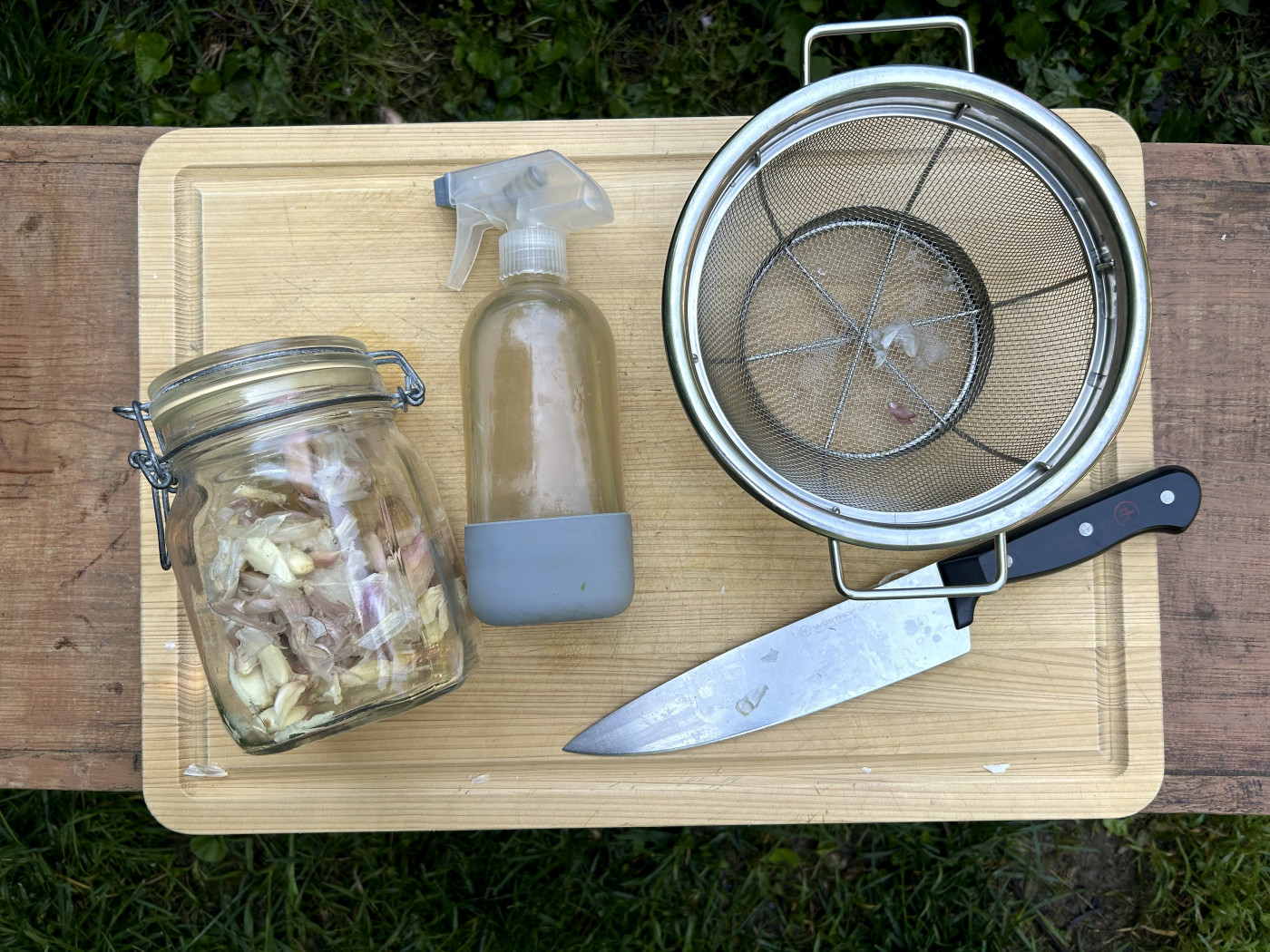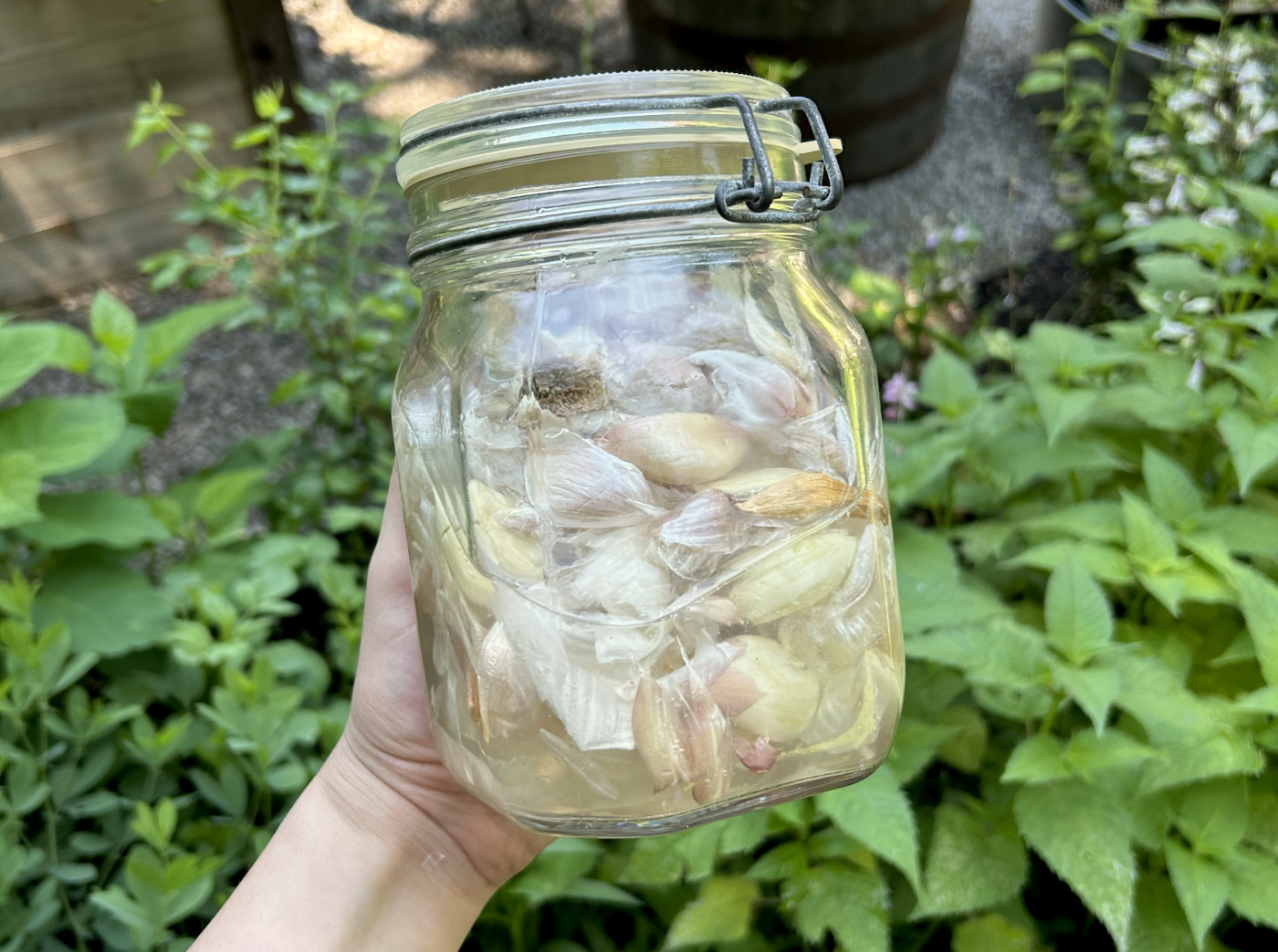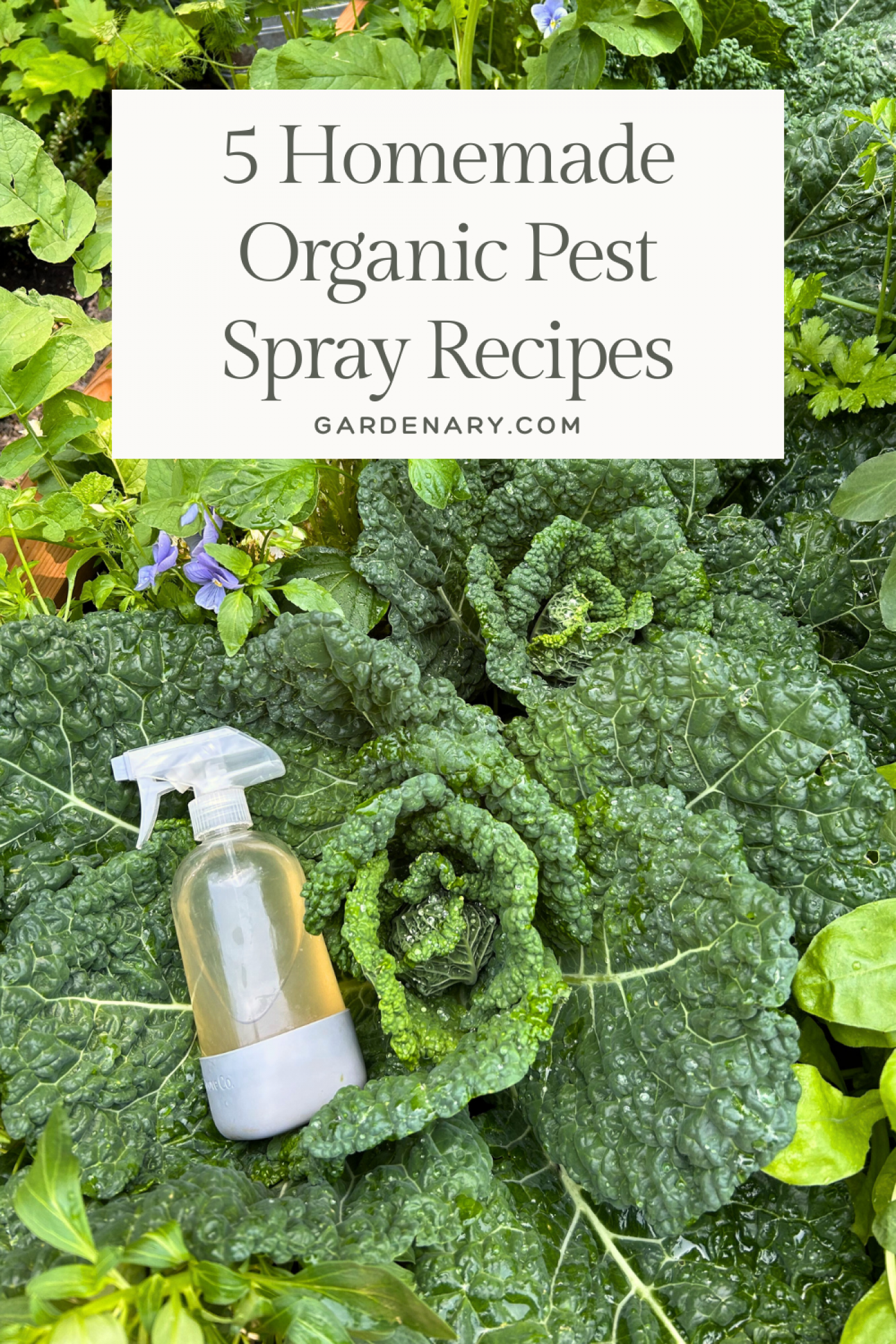DIY Pesticides for Your Vegetable Garden
In an organic garden, sprays should be your last line of defense, not your first. The Gardenary Way focuses on building balance through observation, prevention, and gentle intervention. But sometimes, pests get a little too persistent. When that happens, you don’t need to abandon your organic values or reach for harsh chemical pesticides. Instead, you can turn to natural, homemade sprays that give your garden just the boost it needs.
This guide shares 5 easy, effective spray recipes made with simple ingredients you likely already have in your pantry. While even organic sprays should be used sparingly—too much can still harm pollinators and other beneficial insects—these recipes are designed to give your plants a fighting chance without disrupting the ecosystem you’ve worked so hard to build.
You’ll also learn when and how to apply these sprays so they help restore balance, not create new problems.
At a Glance
- There are many gardening techniques that can be used to avoid the need to spray pesticides (organic or otherwise) at all, including companion planting, trap cropping, maintaining soil health, and using physical barriers.
- Even homemade pest sprays should be used sparingly and applied in the early morning or evening to protect plants and pollinators.
- These DIY insecticidal sprays and repellents use common household ingredients like dish soap, garlic, chili powder, and vegetable oil to make an ideal alternative to harsher chemical sprays.
The Best Pest Control Starts With a Healthy Garden
There's no single solution to protect your vegetable garden from insect pests. That being said, there are lots of things you can do to keep your garden healthy and prevent the worst types of pest pressure. If you focus on these efforts, you won't feel as compelled to reach for harsh pesticides the minute you notice some pest damage.
So before resorting to using pesticides (even organic ones), consider the following techniques to help control insect pests in your garden:
- USE COMPANION PLANTING TO REPEL PESTS NATURALLY. Aromatic herbs, flowers, and alliums are three key companion plant groups to help you control pests. → Learn more here.
- ADD PHYSICAL BARRIERS. Something as simple as garden mesh and row covers block pests' access to your garden, especially tender transplants. You can even place collars (something like toilet paper rolls) about 1 to 2 inches down into the soil around transplants to deter pests like cutworms. → Learn more here.
- PLANT TRAP CROPS TO PROTECT MAIN CROP. If you know that certain pests will be a problem in your garden, give those pests sacrificial plants so you can grow your main crop without stressing. → Learn more here.
- ATTRACT BENEFICIAL INSECTS TO YOUR GARDEN. These insects prey on and even parasitize common pests. The classic example would be ladybugs keeping aphids in check for you. The more beneficials you have in your garden, the more balanced your little ecosystem will be. In other words, your garden is unlikely to suffer major pest problems. → Learn more here.
- FOCUS ON MAINTAINING HEALTHY SOIL. Think of your soil as the microbiome of your garden. It needs to be kept healthy in order to nourish plants and help them grow strong. And strong plants, of course, don't attract as many pests; if they do face pest or disease issues, they're much better equipped to fend for themselves than weak plants. One way to keep your soil healthy is to avoid using synthetic fertilizers, which can strip the soil of its natural fertility. Plus, over-fertilized plants actually attract more pests. → Learn more here.
- FOLLOW BEST WATERING PRACTICES. Thirsty plants are stressed-out plants, and stressed-out plants literally call out to pests (we just can't here them). Maintain consistent soil moisture. → Learn more here.
- LEARN HOW TO ID GARDEN PESTS. Some pests look a lot like beneficial insects that you actually want to keep around. Take a picture of any insects you find on your plants and then do a reverse image search. If it is a pest, then knowing what type will help you come up with a targeted treatment plan for your garden. It's also helpful to know what the larvae and eggs of different insects look like. Ladybug larvae, for example, can actually look like scary pests before they become their cute adult selves. → Learn more here.
Gardenary's Organic Pest Control Method
Stop fighting pests. Instead, start gardening with them in mind. No panic. No harsh sprays. No endless guessing. Just a thriving, abundant garden that practically protects itself. With the Organic Pest Control Method, you’ll learn the exact steps I take to grow naturally and confidently, season after season.

How to Apply Homemade Pesticides Correctly
All right, so you've covered your garden and planted companion plants and trap crops, and you still have a pest problem. I recommend following these steps to deal with the issue first. Take a moment to observe what’s really happening in your garden. Is spraying truly necessary, or is there a gentler way to respond?
If you decide that spraying is necessary, turn to one of these homemade alternatives rather than reaching for harsh chemicals.
Even organic sprays can be harmful if misused (or just ineffective), so it’s important to apply them with care. Timing, placement, and frequency all matter. Spraying at the wrong time of day, hitting beneficial insects, or using sprays too often can do more harm than good.
If you do spray, follow these tips:
- AVOID FULL SUN. Spraying in direct sunlight can scorch leaves. Aim for early morning or late evening.
- PROTECT POLLINATORS. Skip spraying when bees and other beneficial insects are active. Again, early morning or dusk is best.
- USE SPARINGLY. Even organic sprays can stress plants and disrupt garden balance if overused. Avoid spraying on plants that aren't suffering pest issues.
- KNOW YOUR ALLIES. Learn to identify beneficial insects like lacewing larvae and parasitic wasp cocoons, and avoid spraying where they’re present.
- HARVEST FIRST. Harvest any mature fruits and leaves before applying a DIY pest spray. If possible, avoid spraying parts of the plant you'll want to eat. None of these sprays are dangerous to your health, but you may not enjoy the flavor.
- PATCH TEST. Avoid spraying tender young leaves or heat-sensitive plants unless you've done a patch test by spraying on a small area of one affected plant to see how it tolerates the spray.
- PROTECT YOURSELF. Wear protective clothing while applying the spray, and wash your hands afterwards, especially if you're using our hot pepper recipe.
Head's Up: This article contains Amazon affiliate links. When you purchase through links on this site, we may earn a small commission.
How to Make Organic Insecticidal Sprays with Household Supplies
Below, you'll find simple but effective recipes for natural pesticides and repellents. These sprays can replace toxic commercial sprays that have harmful effects on human health, wildlife, and the environment.
To apply these natural spray options, grab yourself some spray bottles like these or clean out old household spray bottles really well. (My bottle pictured below is a glass option from Grove.) You'll also want to use a superfine mesh strainer or something like cheesecloth to strain the mixtures when mentioned in the directions to avoid clogging your sprayer. Lastly, do not add more soap than directed. It'll just gum up your sprayer.
Keep in mind that whichever spray you whip up will need to be applied at least once a week—twice if it rains—until the pest problem has been resolved.
Dish Soap Spray
This gentle, effective spray is one of the simplest tools in your organic pest control kit. Made with just mild soap and water, it targets soft-bodied pests by breaking down their outer coating, helping to reduce their numbers without harsh chemicals. This is called a contact insecticide because it only works when it comes into direct contact with the targeted pest.
Dish soap spray is quick to mix, easy to apply, and a great first step when pest pressure starts to build.
Works Best for:
Aphids, mealybugs, spider mites, thrips, and whiteflies
Ingredients:
- 1–2 teaspoons Dr. Bronner’s castile soap (or another mild liquid soap without bleach, degreasers, or detergents added)
- 1 quart water
Instructions:
Mix gently before use.
How to Use:
- Soapy solutions can be harmful to some plants, so do a test spray on a small area, wait 24 hours, and then see if there was a negative effect.
- Spray directly onto soft-bodied pests.
- Reapply every 3 to 5 days as needed for continued control. These soap sprays only work when wet.
- After a few applications, spray the plants down with water to rinse off any remaining soap residue.
Pro Tip:
You'll notice that almost all of these recipes contain a bit of liquid soap. That's to help your organic pest control spray adhere to the plant’s leaves. I've always used Dr. Bronner's pure liquid castile soap in my garden.
Tomato Leaf Spray
Tomato leaves contain natural compounds (solanine and tomatine) that help deter many soft-bodied pests and chewing insects. This simple spray uses those compounds to protect your plants without synthetic chemicals. Just be sure to avoid using it on other nightshade crops, as it may cause sensitivity.
Works Best for:
Aphids, mites, caterpillars, and other chewing insects (though not tomato hornworms, unfortunately)
Ingredients:
- 2 cups chopped tomato leaves
- 4 cups water (divided)
Instructions:
Soak chopped tomato leaves in 2 cups of water overnight. Strain, then dilute with the remaining 2 cups of water.
How to Use:
- Spray on the affected plants in the early morning or evening.
- Repeat every few days as needed.
Note: Avoid spraying crops in the nightshade family (like tomatoes, peppers, potatoes, and eggplant).


Garlic Oil Spray
Garlic is a powerful natural pest deterrent thanks to its strong scent and sulfur compounds, which many insects and soft-bodied pests can’t stand. This garlic oil spray offers a long-lasting, garden-safe option for managing a variety of common pests. With regular use, it can also help deter slugs and snails from settling in. If you don't feel like making your own, you can buy a garlic barrier spray.
Works Best for:
Aphids, beetles, cabbageworms, squash bugs, slugs, snails, and whiteflies
Ingredients:
- 3–4 garlic cloves, minced
- 2 teaspoons mineral or vegetable oil
- 1 pint of water
- 1 teaspoon Dr. Bronner’s castile soap
Instructions:
Mince garlic and combine with oil. Steep overnight.
Strain and mix the infused oil with 1 pint of water and soap.
How to Use:
- Spray on leaf surfaces and undersides in the evening.
- Reapply weekly or as needed.
Tip: For slugs and snails, boil garlic in water, dilute, and spray around the base of plants as a natural barrier.
Hot Pepper Spray
Keep your garden pest-free with this simple, natural hot pepper spray. Perfect for tackling chewing insects, this homemade solution uses spicy pepper to deter pests without harmful chemicals (well, assuming you don't get capsaicin in your eye!). It's easy to mix and safe for your plants when used correctly—a great eco-friendly way to protect your garden.
Works Best for:
Rabbits, deer, aphids, beetles, mites, whiteflies, caterpillars, ants, and other chewing insects
Ingredients:
- 2 tablespoons hot pepper sauce or chili/cayenne powder
- A few drops of Dr. Bronner’s castile soap
- 1 quart of water
Instructions:
Mix all ingredients together and let the mixture steep overnight.
How to Use:
- Spray on affected plants, avoiding eyes and skin contact (gloves are a great idea!).
- Apply weekly or after signs of new infestations.
- Use in the early morning or evening to prevent leaf burn.
Note: If you have hot peppers growing in your garden, use 1/2 cup of chopped peppers to make a fresh spray. Just puree the peppers in 1 cup water, then add the puree to 1 quart of water and bring to a boil. Let cool, then strain. Add a few drops of soap before applying.


White Oil Spray
This gentle yet effective DIY pest spray uses vegetable oil and mild soap to control common garden pests. It works by smothering insects, but it's safe for most plants when applied properly.
Works Best for:
Aphids, mealybugs, thrips, mites, and scale insects
Ingredients:
- 1 cup vegetable oil
- 1 tablespoon Dr. Bronner’s castile soap
- 1 quart of water
Instructions:
Combine 1 cup of vegetable oil with 1 tablespoon of soap and mix well to create the oil-soap concentrate. When ready to use, add 2 to 8 teaspoons of this concentrate to 1 quart of water and stir thoroughly to dilute.
How to Use:
- Spray the diluted mixture thoroughly on the affected plants in the early morning or evening.
- Use as needed to control infestations.
Gardenary's Organic Pest Control Method
Stop fighting pests. Instead, start gardening with them in mind. No panic. No harsh sprays. No endless guessing. Just a thriving, abundant garden that practically protects itself. With the Organic Pest Control Method, you’ll learn the exact steps I take to grow naturally and confidently, season after season.

Remember, there's no one-size-fits-all approach to pest control. If one spray isn't working, try another. In some cases, it may be best to just remove the affected plants from your garden and start over. No shame in that!
To learn more about different ways to prevent and manage pests in your garden, check out our brand-new Organic Pest Control Method. Through comprehensive guides and video lessons, we dive into ways to protect your garden without panicking or reaching for harsh sprays. You'll learn the exact steps I take to grow naturally and confidently, season after season.




